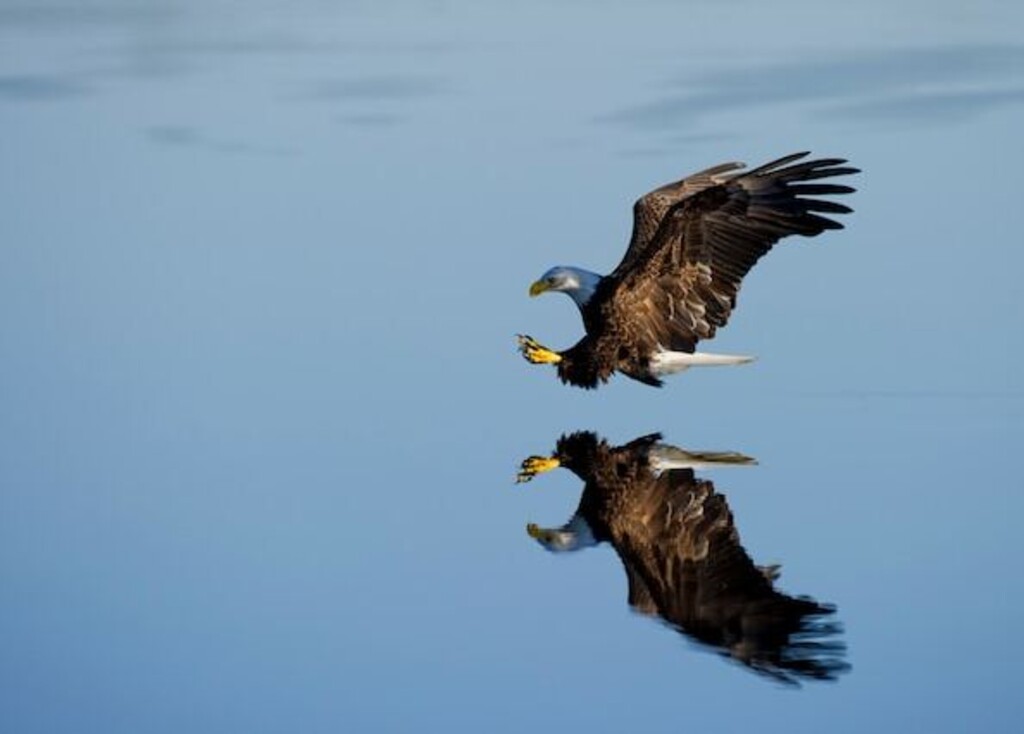Can Eagles Swim? Get ready for a splash of feathered curiosity as we dive into the aquatic world of these majestic birds of prey.
Known for their impressive hunting skills and aerial acrobatics, eagles have captivated humans for centuries.
But here’s the twist: Can eagles actually swim? Despite their prowess in the skies, these formidable predators harbor surprising secrets beneath the water’s surface.
Join us as we unravel the mysteries, exploring their anatomy, hunting skills, and the unexpected talent that allows them to gracefully navigate the waves.
Get ready for an enchanting journey into the depths of eagle swimming prowess!
Table of Contents
- 1 Key Takeaways
- 2 Anatomy of Eagles
- 3 Hunting Skills of Eagles
- 4 Common Misconceptions about Eagles
- 5 Can Eagles Swim
- 6 Ability of Eagles to Swim
- 7 Comparison of Swimming and Flying Abilities
- 8 Reasons for Eagles to Swim
- 9 Challenges Eagles Face while Swimming
- 10 Importance of Swimming Ability in Eagles
- 11 Interesting Facts about Eagles
- 12 Frequently Asked Questions
- 13 Conclusion
- 14 Author
Key Takeaways
- Eagles are capable swimmers with adaptations such as oily feathers, strong wings, and webbed feet.
- Observations show eagles swimming in various bodies of water and using a combination of wing and leg movements to stay afloat.
- Swimming allows eagles to access food sources and escape dangerous situations but they face challenges such as water currents and predators.
- Eagles are highly adaptable and versatile creatures able to thrive in various environments, including swimming when necessary.
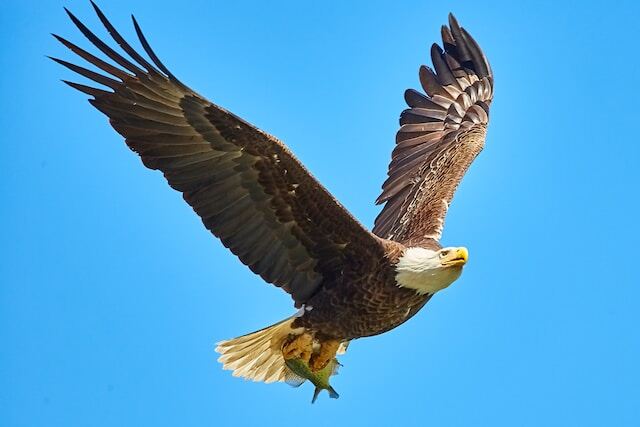
Anatomy of Eagles
The anatomy of eagles is characterized by their sharp talons, strong wings, and keen eyesight, which enable them to hunt for prey effectively.
Eagles have a wingspan that can range from 6 to 7 feet, which allows them to soar high in the sky and spot their prey from a great distance.
Their vision is also remarkable, as they can see up to eight times farther than humans, making it easier for them to detect prey from a long distance.
Additionally, eagles have sharp talons that enable them to grab and hold their prey tightly, while their strong wings provide the necessary lift to carry their prey away.
These physical attributes make eagles one of the most proficient hunters in the animal kingdom. With their exceptional hunting abilities, eagles are able to survive and thrive in their natural habitats.
Moving on to the subsequent section, eagles’ hunting skills are essential for their survival and predatory success.
Hunting Skills of Eagles
One impressive aspect of the hunting abilities of these magnificent birds of prey is their uncanny ability to spot and track their prey from great heights, akin to a skilled sniper picking off their target from afar.
Eagles use a combination of their sharp eyesight, powerful talons, and strong beaks to capture prey that includes fish, small mammals, and even other birds.
Their hunting techniques vary depending on the type of prey they are targeting.
For instance, eagles that hunt fish will soar high above the water, looking for the telltale signs of movement below, before diving at breakneck speed to snatch their prey from the surface of the water with their sharp talons.
On the other hand, when hunting small mammals, eagles will use their keen eyesight to spot their prey from afar before swooping down to grab them with their powerful talons.
Prey selection is also an important part of the hunting skills of eagles, as they are known to be opportunistic hunters that will take advantage of whatever prey is available.
Overall, the hunting skills of eagles are truly remarkable, and their ability to survive in harsh environments is a testament to their supreme hunting abilities.
With this in mind, it is important to dispel some of the common misconceptions about eagles that often lead people to underestimate these incredible birds.
Common Misconceptions about Eagles
A number of common misconceptions have arisen about the impressive hunting abilities of eagles, which may lead to an underestimation of their true capabilities.
One of the most prevalent misconceptions is that eagles are solely hunters of large prey, such as deer or sheep.
In reality, eagles are opportunistic hunters and will prey on a variety of animals, ranging from fish to small mammals.
Another misconception is that eagles are unable to adapt their behavior to changing environments.
However, eagles are highly adaptable and can change their hunting techniques based on the prey available in their environment.
These behavior adaptations demonstrate the intelligence and flexibility of eagles.
Transitioning into the subsequent section about the ability of eagles to swim, it is important to note that another common misconception is that eagles cannot swim.
However, some species of eagles are capable of swimming short distances to reach their prey or escape danger.
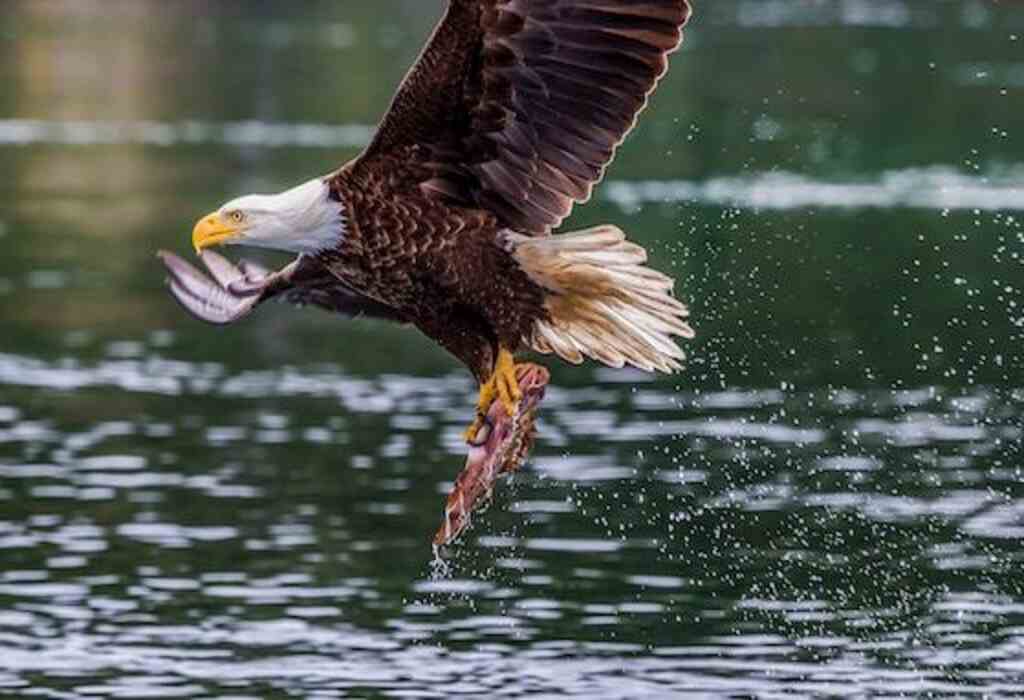
Can Eagles Swim
Yes, eagles can swim. While eagles are primarily known for their soaring flight and hunting skills, they are also capable swimmers.
However, swimming is not their preferred mode of transportation, and they typically avoid water unless necessary.
Ability of Eagles to Swim
Eagles are known for their impressive aerial abilities, but their swimming skills are often overlooked.
Observations have shown that eagles are capable of swimming, although it is not a common behavior.
Eagles have adapted to swimming through features such as oily feathers that repel water, strong wings for propulsion, and webbed feet for maneuvering.
Eagles have been observed swimming in various bodies of water, including lakes, rivers, and oceans.
Observations of Eagles Swimming
Based on observations, it has been noted that when eagles swim, their movements resemble that of a graceful dancer performing a water ballet.
Swimming technique varies depending on environmental factors, with eagles using a combination of wing and leg movements to keep themselves afloat.
They tend to swim with their wings held out to the side, using them to help propel themselves forward.
Additionally, they use their powerful legs to kick and paddle, which helps them to control their movements and maintain balance in the water.
These observations suggest that eagles have developed unique adaptations to enable them to swim when necessary.
As we move into the subsequent section about adaptations for swimming, it is worth noting that these adaptations have likely played a crucial role in the survival of these majestic birds.
Adaptations for Swimming
The unique adaptations observed in the swimming patterns of these avian predators are a testament to the resilience of nature’s design.
Eagles are not known for their swimming abilities, but they have a few tricks up their wings.
To stay afloat, eagles have adapted their feathers to be more water-resistant, allowing them to stay buoyant and avoid becoming waterlogged.
Additionally, the wings of eagles are used to provide propulsion while swimming, much like a paddle. This technique allows them to move through the water efficiently and quickly.
Finally, eagles are able to regulate their body temperature while swimming, preventing them from losing too much heat in the cold water.
These adaptations allow eagles to swim with ease, and it is fascinating to see these predators navigate the water.
Speaking of water, the types of water eagles swim in are just as interesting.
Types of Water Eagles Swim in
Water bodies where eagles wade include rivers, reservoirs, and wetlands. These water habitats provide eagles with a diverse range of prey in water, such as fish and amphibians.
Eagles have adapted to hunting in water by having sharp talons and a curved beak to catch and tear apart their prey.
They also have a keen sense of vision to spot their prey from a distance while flying or perching near the water’s edge.
Eagles are well-suited for swimming in these water bodies due to their large wingspan, which helps them stay afloat, and their waterproof feathers that prevent them from getting wet.
Observing eagles swimming in their natural habitats can be a fascinating sight for those who have a subconscious desire for freedom.
The comparison of their swimming and flying abilities will be discussed in the next section.
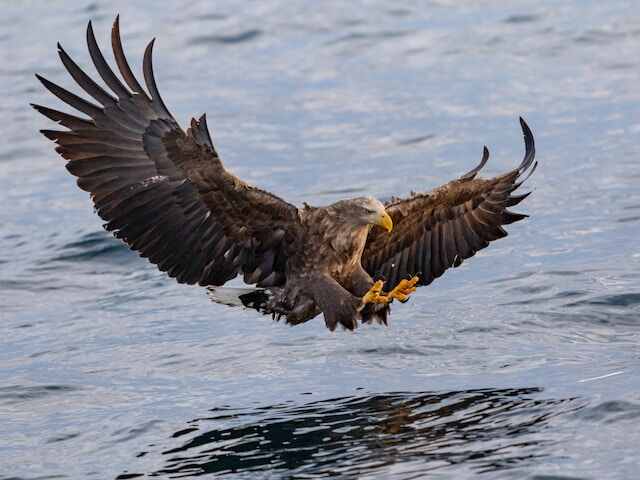
Comparison of Swimming and Flying Abilities
Comparing the swimming and flying abilities of eagles reveals fascinating insights into the evolutionary adaptations of these majestic birds.
While eagles are known for their incredible aerial maneuvers and soaring abilities, they are also skilled swimmers.
Swimming is an important survival skill for eagles, especially when they need to catch fish or escape predators in water bodies.
Here are some interesting points to consider when comparing the swimming and flying abilities of eagles:
- Swimming requires more energy than flying, which is why eagles prefer to fly when possible.
- Eagles use different techniques for swimming and flying. For swimming, they use their wings to propel themselves forward, while for flying, they use their wings to soar and glide.
- The body structure of eagles is adapted for both swimming and flying. Their wings are broad and strong, allowing them to generate lift in the air and paddle through water. Their feathers are also waterproof, which helps them stay buoyant in water.
- Eagles have different adaptations for different types of water bodies. For example, sea eagles have longer legs and sharper talons than other eagles for catching fish in saltwater.
As we can see, eagles have evolved to be versatile and adaptable creatures, able to thrive in a variety of environments. In the next section, we will explore the reasons why eagles swim and how it benefits their survival.
Reasons for Eagles to Swim
Eagles are known for their exceptional flying abilities, but they are also capable swimmers.
There are several reasons why eagles might choose to swim, including hunting and fishing. Swimming can allow eagles to access prey in aquatic environments that they might not be able to catch in the air.
Additionally, swimming can also serve as a means of escape from predators or as a way to migrate to new areas.
Hunting and Fishing
In their search for prey, raptors like eagles have been known to dive at speeds of up to 200 miles per hour. Hunting and fishing are two of the primary reasons for eagles to take to the water.
The following are some of the fishing techniques and hunting strategies that eagles use:
1) Eagles will circle high above their prey, and when they spot a fish, they will swoop down and grab it with their talons.
2) Eagles will hover over the water and then suddenly pounce on a fish, using their sharp talons to grab onto it.
3) Eagles will sometimes use teamwork to catch larger prey, such as ducks or geese, by working together to chase the prey into a corner.
Understanding these behaviors is crucial to understanding the eagle’s role in the ecosystem.
Eagles are not only majestic creatures but also important predators that play a vital role in maintaining the balance of nature.
With this in mind, it is important to note that eagles are not invincible and must also be able to escape from predators.
Escape from Predators
One important aspect of the eagle’s survival is its ability to quickly and efficiently evade potential predators.
Predator avoidance is a crucial skill for eagles, as they are often targeted by other birds of prey, such as hawks and owls, as well as terrestrial predators, including bears and coyotes.
To avoid being attacked, eagles use a variety of survival techniques, such as flying at high altitudes, hiding in dense vegetation, and even attacking their pursuers.
They are also known for their incredible speed and agility in flight, which allows them to make sudden turns and maneuvers to evade predators.
Additionally, eagles have excellent eyesight, which enables them to spot predators from great distances and take evasive action before they are detected.
By using these survival techniques, eagles are able to protect themselves and their young from harm.
As we move into the subsequent section about migration, it’s important to note that eagles also use their predator avoidance skills during their long journeys to their wintering grounds, where they face numerous threats along the way.
Migration
During their annual journey to warmer climates, these majestic birds traverse great distances, facing various obstacles along the way such as adverse weather conditions and lack of food.
Eagles have been known to migrate across continents, with some traveling up to 15,000 miles in a single year.
They use a variety of migration routes, including coastal and inland routes, to avoid harsh weather conditions, find suitable habitats, and locate food sources.
Environmental factors such as wind patterns, thermals, and availability of prey also play a significant role in determining their migratory path.
Eagles are skilled navigators, using their keen eyesight to spot landmarks and orient themselves to their destination.
However, their migration is not without challenges, as they may encounter natural barriers such as mountains, oceans, and deserts that require them to fly over or around.
As we explore the topic of whether eagles can swim, it is important to consider the challenges they face during their migration and how these obstacles may impact their ability to swim in certain situations.

Challenges Eagles Face while Swimming
Eagles face numerous challenges when swimming, including water currents, predators in the water, and exhaustion.
Water currents can be particularly difficult for eagles to navigate as they are not adapted to swimming and can quickly become fatigued.
Additionally, predators such as fish and alligators pose a threat to eagles as they may mistake them for prey.
Finally, swimming long distances can lead to exhaustion, putting eagles at risk of drowning or being caught by predators.
Water Currents
Water currents play a crucial role in determining the movement and direction of aquatic creatures. Eagles are no exception to this rule and must utilize specific swimming techniques to navigate through different currents.
There are three main types of water currents: surface currents, subsurface currents, and deep-water currents.
Surface currents are created by wind patterns and can carry objects and organisms along with them.
Subsurface currents are caused by differences in temperature and salinity, and are often slower and more unpredictable than surface currents.
Deep-water currents are created by changes in water density and can move slowly through the ocean’s depths.
Eagles must adapt their swimming techniques to each type of current to avoid getting swept away or losing energy.
For example, when swimming against a surface current, eagles use a breaststroke technique to keep their heads above water and conserve energy.
On the other hand, when swimming through subsurface currents, eagles use a more streamlined technique, diving deeper into the water to avoid the strongest currents.
Understanding water currents is essential for eagles to successfully navigate through water and reach their destination.
However, even with their adapted techniques, eagles are still vulnerable to predators in the water.
Predators in Water
The aquatic environment is fraught with danger, as predators lurk beneath the surface, lying in wait for unsuspecting prey.
Predator adaptations, such as superior swimming speed, acute visual and auditory senses, and sharp teeth and claws, make them formidable hunters.
Prey vulnerability is heightened by their lack of physical defenses and limited mobility in water. In this environment, predators such as crocodiles, sharks, and alligators reign supreme.
Despite their size and strength, eagles are not immune to attack from aquatic predators. In fact, young eagles are especially vulnerable to attacks from below when learning to fish.
The harsh reality of the water’s food chain is a reminder that even the most skilled and powerful creatures are not invincible.
However, the desire for survival and freedom persists, driving eagles and other animals to continue their quest for sustenance.
Moving forward, the topic of exhaustion will be explored in relation to the challenges faced by eagles in their pursuit of prey.
Exhaustion
Survival in the aquatic environment is a test of endurance, as prey must constantly evade predators or risk being consumed, as the adage goes, ‘survival of the fittest.’
Prey animals need to be able to swim for long periods to evade predators, and a lack of proper technique can quickly lead to exhaustion and death.
For example, tuna and sharks are known for their ability to swim great distances, with some species capable of swimming over 100 miles in a day.
Additionally, some species of birds, like the albatross, can fly for hours without stopping, covering great distances over the ocean.
In contrast, animals with poor swimming ability, such as deer or rabbits, are at a significant disadvantage when it comes to survival in water.
Preventing exhaustion is critical for prey animals, as it allows them to evade predators effectively and stay alive.
Proper technique is also essential to conserve energy and swim efficiently. These factors are crucial for animals that rely on swimming to survive, like fish, seals, and sea turtles.
Understanding the importance of swimming ability in animals like eagles is essential to appreciate their unique adaptations to their environment and survival strategies.

Importance of Swimming Ability in Eagles
The ability to swim is a crucial aspect of an eagle’s hunting strategy and overall success in the wild. Swimming techniques and lifesaving skills are essential for eagles to survive and thrive in their natural habitats.
Here are some reasons why swimming is important for eagles:
1) Swimming allows eagles to access food sources that are otherwise inaccessible, such as fish and other aquatic prey.
2) Swimming helps eagles escape from predators and dangerous situations, such as getting stuck in mud or caught in strong currents.
3) Swimming enables eagles to travel greater distances and explore new territories.
4) Swimming provides eagles with a sense of freedom and independence, allowing them to fully embrace their wild nature.
Interestingly, despite being known for their aerial prowess, eagles are also skilled swimmers. In the next section, we will explore some fascinating facts about eagles that highlight their unique abilities and behaviors.
Interesting Facts about Eagles
While swimming ability is important for eagles, there are many other interesting behaviors and characteristics that make these birds of prey fascinating creatures.
For example, did you know that eagles have incredibly sharp eyesight and can spot prey from over a mile away?
Or that they are known for their impressive aerial acrobatics, including barrel rolls and steep dives?
Additionally, eagles have specific habitat preferences, with some species preferring forested areas while others live near bodies of water.
To explore some of the unique traits and qualities of eagles, take a look at the table below, which highlights a few interesting facts about these majestic birds.
| Species | Wingspan | Preferred Habitat | Diet |
|---|---|---|---|
| Bald Eagle | 6-7 feet | Near water bodies, forested areas | Fish, small mammals, birds |
| Golden Eagle | 6-7.5 feet | Mountains, open landscapes | Rabbits, hares, other small mammals, birds |
| Harpy Eagle | 6-7 feet | Tropical rainforests | Sloths, monkeys, birds |
| White-Tailed Eagle | 7-8 feet | Coastal areas, wetlands | Fish, birds, mammals |
As you can see, eagles have a diverse range of habitat preferences and diets, making them adaptable and versatile predators. Whether soaring through the skies or perched on a tree branch, these birds never fail to captivate and inspire awe in those who observe them.
Frequently Asked Questions
How long do eagles typically live in the wild?
The average lifespan of a wild eagle varies depending on species, with bald eagles living up to 20 years and golden eagles up to 30. Breeding patterns, habitat preferences, and migration patterns also impact longevity.
What is the average wingspan of an eagle?
The average wingspan of an eagle varies among species, with the largest belonging to the Stellar’s sea eagle at 7.5 feet. Eagle anatomy and wing adaptations allow for powerful flight and soaring, which aids in their migration patterns.
How do eagles communicate with each other?
Eagles communicate with each other through various methods including vocalizations, body postures, and visual displays. This is important for social cohesion, mate selection, and territory defense. Understanding these communication strategies can aid in conservation efforts.
What types of prey do eagles commonly hunt?
Eagles commonly hunt prey such as fish, small mammals, and birds using their sharp talons and keen eyesight. However, human activity has impacted prey availability and eagle hunting techniques, leading to potential threats to their survival and freedom in their natural habitats.
Are eagles endangered and if so, what measures are being taken to protect them?
Conservation efforts have been underway to protect various eagle species, as many face threats of habitat loss and illegal hunting. Habitat preservation and protection laws have been established to safeguard their populations and ensure their continued survival.
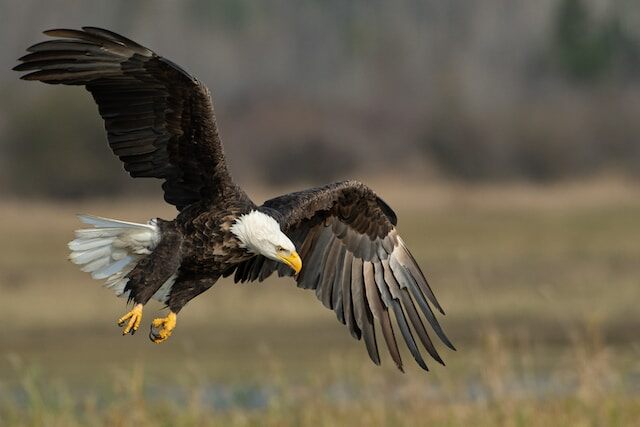
Conclusion
The majestic eagle, with its formidable hunting skills and impressive wingspan, has long been regarded as one of nature’s most awe-inspiring creatures.
However, there are many misconceptions about this bird of prey, including the belief that eagles are unable to swim.
In reality, eagles are capable swimmers, although their swimming abilities are often overshadowed by their impressive flying skills.
The anatomy of an eagle is well-suited for both flying and swimming. With their powerful talons, sharp beaks, and keen eyesight, eagles are well-equipped to hunt both on land and in water.
However, while eagles are capable swimmers, they are not as comfortable in the water as they are in the air.
Swimming poses several challenges for eagles, including the weight of their feathers and the need to keep their wings dry.
Despite these challenges, eagles have been known to swim in order to catch prey or escape danger.
While they may not be as graceful in the water as they are in the air, eagles are still impressive swimmers.
In fact, watching an eagle swim can be quite a sight to behold. So, the next time you see an eagle near a body of water, don’t be surprised if it takes a dip.
In conclusion, the idea that eagles cannot swim is just one of many misconceptions about these magnificent birds.
While their swimming abilities may not be as well-known as their flying skills, eagles are still capable swimmers.
So, the next time someone tells you that eagles can’t swim, feel free to set the record straight. After all, these birds of prey are capable of some pretty amazing things, both in the air and in the water.

